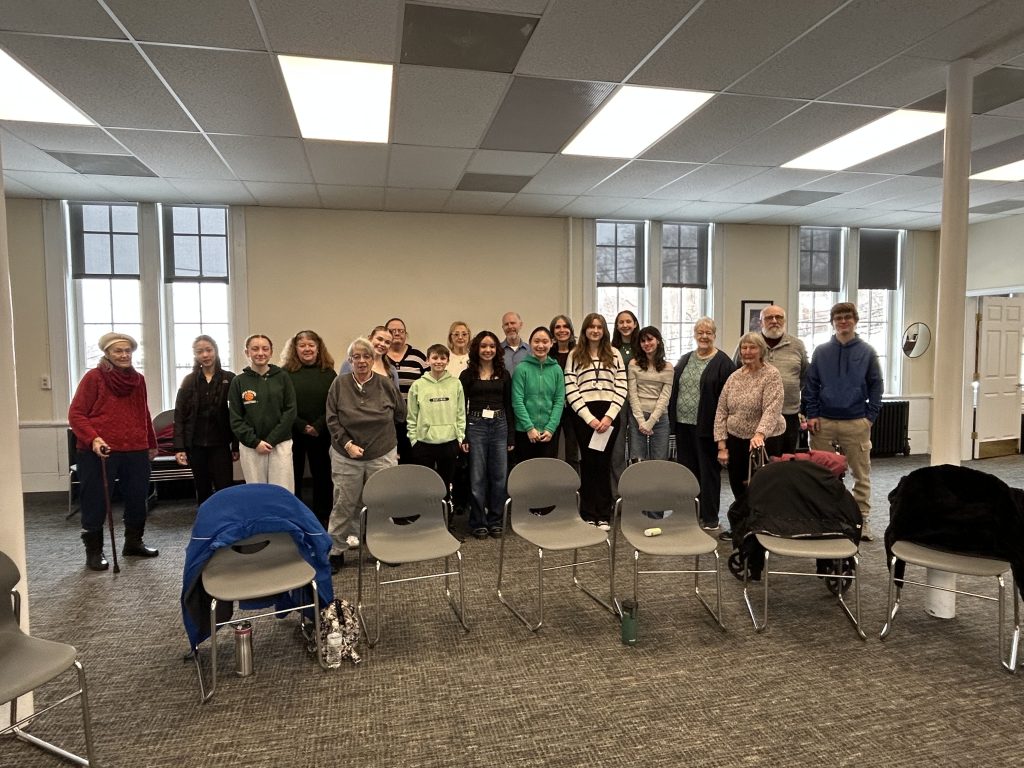
By EVA HANEGRAAFF
NORTH READING — Having conversations with people other than oneself is a well known method of broadening horizons and expanding frame of reference. Having mature conversations and opening up about sensitive feelings is not a practice that comes easily to everybody, especially when unfamiliar and dissimilar people are involved.
NRMS students take on this challenge beautifully, working with the Senior Center in what are called “restorative circles,” or a method of communication that incorporates a circle of chairs and prompted conversations that foster different perspectives and opinions. Along with sitting in a circle, participants also utilize a “talking stick” that is used to signify whose turn it is to share.
“It’s really helped me understand the older generations,” eighth grader Tyler Costello explains. He goes on to say, “a group of that many seniors can give so many different experiences.” Costello’s experience is mirrored by another eighth grade student involved in the program. Alyssa Casassa explains, “It’s really enlightening to be with a group of people who have so much experience in life and such different experiences than we’ve been through so far because their childhoods were completely different than ours.”
Both students express their appreciation for the program and fondly regard the restorative circles they have been a part of. Both eighth graders agree that it has expanded their view of the world around them and helped to break down the stereotypes that previously may have affected their perspectives and that of others.
“It helps us understand each other more and between generations, a lot gets lost in translation,” Casassa said, explaining, “The younger generation is known for being super tech savvy and the older generation is known as not knowing what to do with phones, but through the circles we learn that not every kid likes having a phone and not every senior citizen is horrible with technology.”
For both Costello and Casassa, the circles have taught them a lot. “It takes a certain level of maturity to speak to an adult respectfully and learn from their experiences,” Costello states.
Maturity is a very apparent quality within all the eighth graders who participate in the circles. “The senior citizens have said that they can’t believe they’re in the eighth grade,” commented Middle School Principal, Dr. Catherine O’Connell, explaining that the depth and reflectiveness “some of their answers are have surprised the senior citizens in terms of what they thought a 14-year-old would be thinking.”
The maturity, introspectiveness, and breaking down of stereotypes that is practiced within the sanctity of the circles does not stop there. Costello explains the impact the program has had on his everyday life as well. “I’ve gotten a lot out of it and been more open minded about others and been able to break the stereotypes I may have had before,” he said.
It is true that not just senior citizens and middle schoolers are the only ones who could learn something from the program. O’Connell has been actively looking into starting a circle with members from both her middle school volunteers and elementary school students. With this new idea, it would be a bigger change for the eighth graders than one may initially be led to think. “I feel like it’s going to be a little harder because you have to do more of the talking,” Costello says. Cassasa adds on, “I’m excited to continue to be able to share in a nonjudgmental place with a new group. I think being a role model for the younger generation is important and I’m not a perfect person but I would like to improve the younger generation however I can.”
The program has been going on since the start of the school year, with many different circles, covering a variety of different topics. Within all the circles they have participated in, Casassa, Costello, and O’Connell reached a unanimous consensus on their favorite. At this circle, everyone needed to prepare their favorite song and send it in. Throughout the conversation, each song would be played and the individual who sent in the song would be given time to explain it and their reasons behind why the song is meaningful to them.
“I feel like it helped everyone open up a lot because a lot of people’s lives can be captured in a song,” Casassa says, adding, “music connects a lot of people; it’s a language that we can all speak.”
All in all, restorative circles are a majorly innovative practice, changing the way the generations of North Reading interact with each other. In addition to breaking down stereotypes and fostering communication, this program has been successful in changing the way both the middle schoolers and senior citizens observe the world around them, allowing them to be more open minded in their everyday lives.
